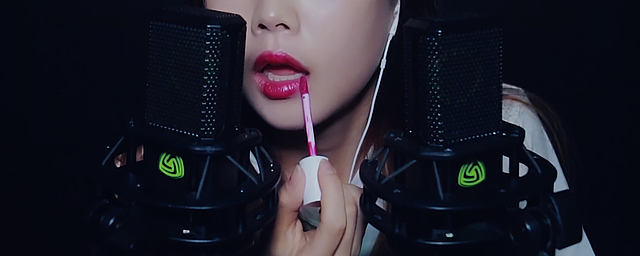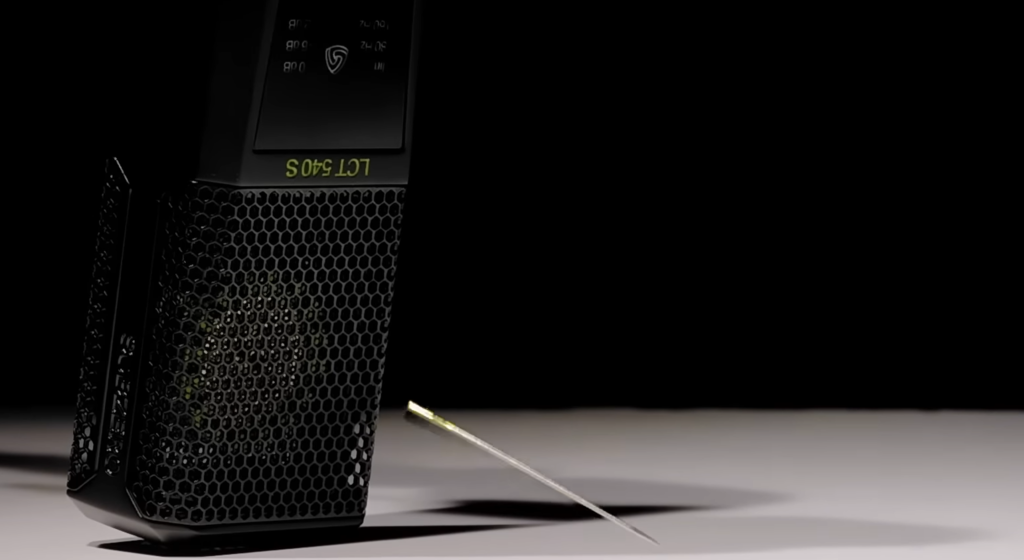
Blog
True love for great sound unites us.
Blog
True love for great sound unites us.
ASMR is still one of the hottest trends on YouTube.

ASMR is still going strong in 2024, and the trend has found its own space within content creation. In this article, we will give you a complete guide on how to start your ASMR channel. You will find helpful insights into ASMR, the right equipment, and tips & tricks on how to get a better ASMR sound.
The term ASMR stands for Autonomous Sensory Meridian Response.
It is often described as a tingling, static-like sensation that refers to a relaxing, often soothing feeling that spreads from the scalp and moves down the back of the neck and upper spine. Over the past few years, a subculture has developed around YouTube videos and their growing popularity.
This "head tingling", as some call it, is caused by pleasing images and gentle sounds. Like whispers, accents, and crackles. Maybe you have experienced feeling sleepy or relaxed while getting a haircut or hearing someone explain something slowly and gently. Sounds from nature are also a good example.
As a matter of fact, over the last few years, more and more people are getting interested in ASMR.
To know what we are talking about, let's first listen to some sound samples of ASMR recordings. We have prepared a few different ones.
According to an ASMR study from the University of Sheffield and Manchester Metropolitan University, the videos are often used to fall asleep, relax or relieve stress.
Dr. Poerio said: “Our studies show that ASMR videos do indeed have the relaxing effect anecdotally reported by experiencers – but only in people who experience the feeling.
This was reflected in ASMR participants’ self-reported feelings and objective reductions in their heart rates compared to non-ASMR participants.
What’s interesting is that the average reductions in heart rate experienced by our ASMR participants was comparable to other research findings on the physiological effects of stress-reduction techniques such as music and mindfulness.“
Dana Park, a popular producer of ASMR videos who started her channel Dana ASMR back in 2013 explains: “My viewers and listeners watch my videos when they want to relax, fall asleep, or even just focus on something.
Many of them tell me that my videos have helped them with anxiety, depression, and insomnia.
Others tell me that ASMR videos make them feel very relaxed and cozy, so they watch them at the end of the day before going to bed.
I wouldn’t say that these videos are guaranteed to help you with anything, but I’ve gotten lots of feedback from people who’ve told me that they help them to feel better. And this feedback from people is one of the main reasons I’ve kept doing ASMR videos.”

Dana Park first encountered ASMR in high school, having difficulty sleeping due to the extreme stress of preparing for university. So she searched for relaxing sound videos on YouTube and fell asleep within 5 minutes after listening to her first ASMR video.
After this experience, she fell in love with ASMR!
Dana's favorite ASMR microphone
There are different styles of ASMR channels, and every ASMR artist or ASMRtist uses different techniques and triggers.
Here are some of the most popular ASMR triggers for beginners:
Whisper or soft talk: The aspects of your voice, which can influence ASMR are speed, volume, tone, and emotion. Many artists talk slowly, which expresses a calm disposition that may be relaxing to the listener.
Fingernails gliding, scratching or tapping: The simplest sounds can make for a relaxing feeling. For example, fingernails tapping a glass, leafing through a magazine, or crumpling paper and various materials or playing with latex gloves, old cassette tape, and your favorite everyday items.
Eating sounds: One of the most popular disciplines in the ASMR scene is eating sounds. Noises with the lips (smacking) or the tongue (snaps) while eating a lobster, cake, or whatever is available in your fridge can trigger ASMR.
Role plays: A spa massage or a visit to the barbershop can cause head tingling. It makes many listeners believe that they are sitting at the hairdresser or lying on the massage table. Popular with men: a decent beard shave with shaving cream!
Skincare and make-up: Swiping the brushes on the microphone, swabbing the cotton balls, and applying nail polish are popular "trigger" sounds.
When you’re trying to find out what kind of videos you want to make, keep in mind there are no limits to your creativity.
Another thing you might want to consider is the community aspect of your channel.
Keep your uploads consistent and interact with your viewers as much as possible. Make them feel special!
On the one hand, your community can be inspiring, and it is always a good idea to consider people’s requests when deciding what video to film next. Go through all comments on each video and evaluate the helpful suggestions people leave.
On the other hand, it is no secret that there are many haters out there, that will try to give you a hard time. Don't let them stop you, and this will help you to get a thicker skin and to find the strength to handle negative feedback.
Furthermore, try not to feel discouraged if you don’t get too many views and subscribers right from the beginning. Building a community takes time, and there are lots of ASMR channels out there these days. It can help to imagine those people that viewed your video as an audience in front of you, and you’ll realize that it’s quite a lot!
To get a good ASMR recording, or any recording, you need to consider three main factors:
The gear
The source
The room
Those three factors are interdependent, and all three need to be considered. If one of them is lacking, the result will suffer! We will show you some easy tricks that will help you to get a better sound out of your ASMR performance.

Pierre G, Dana Parks, and PJ Dreams favorite microphones
The gear you use plays a vital role in the quality of your ASMR recordings. With subpar gear, you will not get your dream ASMR audio.
To make the best decision when choosing your gear, you must know what important aspects are.
The next section will teach you how to choose the right microphone and other audio gear.
Investing in the best ASMR microphone possible will bring your channel to the next level because sound quality is essential for a good listener experience.
The microphone will connect you with your community.
There are two main factors you must pay close attention to when choosing a microphone for your ASMR recordings:
Self-noise
Each microphone model has a specific inherent self-noise.
In simple terms, self-noise, or equivalent noise level, is the noise that a microphone produces by itself, without recording an instrument or vocals.
You want your audience to experience every little detail and not be distracted by an annoying hum or hiss in your recording.
The lower the microphone’s self-noise, the better. For optimal ASMR recordings, we recommend microphones below 10 dB(A) self-noise.
The LCT 540 S is the quietest microphone. It has an astoundingly low self-noise value of only 4 dB(A). Less quiet microphones can have to about 20 dB(A).
If you want to learn more about the topic, check out the blog about microphone self-noise.
Microphone sensitivity
When recording ASMR, you want to capture as many subtle details as possible. A more sensitive microphone produces a stronger output signal for the same sound source, making it better at picking up quieter sounds.
Sensitivity is an important specification for ASMR recordings. It tells you how effectively a microphone converts sound into an electrical signal.
Sensitivity is measured in millivolts per pascal (mV/Pa) or as a decibel value relative to 1 volt per pascal (dBV/Pa).
The closer the dBV/Pa value is to 0, the higher the microphone's sensitivity.
The LCT 540 S, a popular ASMR microphone, has a high sensitivity of -28 dBV/Pa. A typical dynamic microphone, which is known to be less sensitive, is about -54 dBV/Pa.
The LCT 540 S is the world's quietest microphone regarding self-noise; it is even better than human hearing.
It is ideally suited to capture your ASMR triggers in every detail.
With the LCT 540 S, you can experiment with sounds in unprecedented ways and perfect your recordings by capturing all the fine-grained characteristics that constitute each moment of your performance.

LCT 540 S has a self-noise of only 4 db(A), and a sensitivity of -28 dBV/Pa
LCT 640 TS
The LCT 640 TS microphone allows you to record in stereo using only one but requires two channels on your audio interface. The reward is a fantastic stereo image, great localization, and an almost binaural quality.
LCT 640 TS and LCT 540 S are flagship microphones with features like a low-cut filter, which can filter low frequencies like rumble when activated.
LCT 640 TS has a self-noise of only 10 db(A), and a sensitivity of -30.1 dBV/Pa
The LCT 440 PURE is the most affordable solution. It also features low self-noise and has the same capsule and design as our flagship mics.
We hope this article provided helpful tips, and we wish you lots of fun creating your own ASMR videos.
When selecting a suitable audio interface for ASMR, you should pay attention to the following 2 things:
You want 2 XLR inputs to record in stereo for the best ASMR results.
And as we have learned already, you want to minimize noise in your recordings. So, ensure that your audio interface has low-noise and high-gain preamps.
You want the interface to have at least 60 dB of gain, so you can capture audio in great detail. The interface's preamps should also have a noise floor of 126 dBu(A) or lower. If you’re unsure, check if Julian Krause (https://www.youtube.com/@JulianKrause/videos) has a review for the interface you are looking at. He makes great and technically detailed reviews, re-checking everything the manufacturer says. We highly recommend his channel!
Our recommendation
The CONNECT 6 is an excellent interface to record ASMR. It has everything you need. Great low-noise and high-gain preamps, 2 XLR inputs, and impressive connectivity options. You can’t go wrong with it.
When we think about the fact that many people using ASMR to fall asleep, you should keep in mind that ears work better when you’re closing your eyes because the sense gets sharpened that way. With this knowledge, one could say that the visual aspect of an ASMR video is not equally important as its sound.
Another thing worth mentioning is that lighting is the key to a good-quality visual result in your video.
Even the most expensive camera will not help you if your lighting situation is terrible.
Last but not least, we’re living in a time where modern system cameras are the best bang for your buck and provide all you need for a professional-looking ASMR video.
Some of the ASMRtists use iMovie (FREE), DaVinci Resolve (FREE), Adobe Premiere (PAID), or Final Cut (PAID).
It’s crucial that you make sure that your video is in sync with your audio.
Multiple YouTubers are using additional software, a professional digital audio workstation (DAW) to get rid of unwanted noise and other unpleasant sounds.
When choosing microphone cables, again this is a question of budget. Choose something within your price range and focus on quality XLR connectors (Neutrik or similar), because those are usually the weak points of cheaper cables.
Based on your budget, there are lots of good free options like Audacity, Cakewalk, or Garageband.
A recording can only be as good as the ASMR performance, so always keep that in mind. Apart from delivering excellent performance, it will help you to have a certain amount of mic discipline.
Some call it microphone technique, but in the case of ASMR, we should talk about discipline because it involves a lot of details that might seem small, but they can have a significant impact. A few things you should consider are:
When recording micro triggers such as whispering, breath sounds can become overpowering. To avoid this, try to breathe away from the microphone.
Sibilance: Sometimes, “S” sounds become sharp and annoying. Some individuals encounter that more than others since it depends on your teeth. Also, specific microphones react more to those sounds than others.
If you want to reduce the sibilance while recording, try not to talk directly into the microphone but a little off-axis. This will reduce the high-frequencies the microphone picks up.
Plosives: Another problem you will most likely encounter is the so-called plosives. Mostly noticeable in sounds P, T, and B.
Those letters can cause bursts of air, which can ruin your recording, so it is standard to use a pop filter. Additionally, the windshield can be used to reduce plosives further.
Proximity effect (distance): Some of you might have heard about the so-called proximity effect.
Explaining this phenomenon in all its technical details would go beyond the scope. So, to avoid confusion, let’s keep it simple:
The term proximity effect describes an increase in bass response when you get close to a directional microphone. Starting at about 25-30 cm, the closer you get to the membrane, you will notice that your voice gets more and more bass added. Keep this in mind while recording.
Clothing: This might sound surprising, but your clothing can also have an impact on the recording.
Some materials are very loud; when you move, this can get very annoying when you’re trying to record very subtle sounds.
Before recording your first ASMR video, experiment a little bit on how your microphone reacts to certain things. Knowing your equipment will always help you to get better recordings.
Since ASMR is mainly recorded in a lovely room at someone’s home instead of a professional acoustically treated recording studio, you can run into issues here. But the good news is that there are easy modifications you can make to get the best ASMR sound possible out of your room.
Background noise: While you can ensure that the washing machine, computer fan, or air conditioner is not running while you’re producing your ASMR video, some other noises can’t be turned off, like street noise. But with street noise, choosing a good time can help to influence the amount of noise you’ll get in your recording. That is why many YouTubers record their videos late at night to avoid unwanted street or airplane noises.
Room reflections: Reflective walls or surfaces in the recording space can become problematic, especially if two naked walls face each other. You might have noticed this in a bathroom or while moving into a new, empty apartment. The phenomenons we’re talking about are “comb filtering” and “flutter echo.” It would take way too much time to go really into detail about room acoustics. Just keep in mind that absorbers are your friends. Even if it’s just a thick curtain on the windows, a carpet on the floor or wall, and even opening your wardrobe helps. Every little bit will help you, at least with the high frequencies.
Where to record in your room: Mic placement is crucial. Room resonances or standing waves can become problematic. When you blow into an empty bottle, you get a specific tone. Just like an empty bottle, a room has many resonances. Finding the right spot in your room is a matter of trial and error.
It will help to know your room. Move your recording setup until you find the spot that works best. If it is not feasible to lift the equipment in this position (in front of the TV, for example) mark the spot on the floor with tape to easily find it again and to keep consistency.